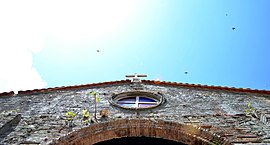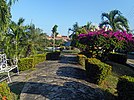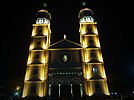
Venezuela is a country in South America, bordering the Caribbean Sea and the North Atlantic Ocean, between Colombia and Guyana. It is situated on major sea and air routes linking North and South America. Located at the northernmost end of South America, Venezuela has a total area of 912,050 km2 (352,140 sq mi) and a land area of 882,050 km2 (340,560 sq mi). It is the 32nd largest country and is slightly smaller than Egypt, or half the size of Mexico. Shaped roughly like an inverted triangle, the country has a 2,800 km (1,700 mi) long coastline. It is bound on the north by the Caribbean Sea and the Atlantic Ocean, on the east by Guyana, on the south by Brazil, and on the west by Colombia. It has the 55th largest Exclusive Economic Zone of 471,507 km2 (182,050 sq mi). Its maritime territory borders Trinidad and Tobago, Dominica, the Dominican Republic, Grenada, St. Kitts and Nevis, St. Vincent and the Grenadines, France, the United Kingdom, the Netherlands, and the United States. The Guyana–Venezuela territorial dispute has continued since the nineteenth century, with Venezuelan claiming a territory it calls "Guayana Esequiba", which is currently controlled by Guyana.
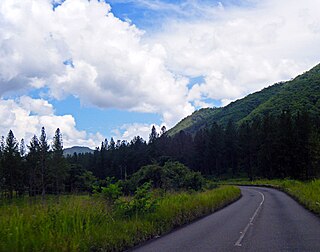
Monagas State is one of the 23 states of Venezuela.

Ciudad Bolívar, formerly known as Angostura and St. Thomas de Guyana, is the capital of Venezuela's southeastern Bolívar State. It lies at the spot where the Orinoco River narrows to about 1 mile (1.6 km) in width, is the site of the first bridge across the river, and is a major riverport for the eastern regions of Venezuela.

Barcelona is the capital of Anzoátegui State, Venezuela, and was founded in 1671. Together with Puerto La Cruz, Lecheria and Guanta, Barcelona forms one of the most important urban areas of Venezuela, with a population of approximately 950,000.

Valle de la Pascua is the capital city of the autonomous municipality of Leonardo Infante, Guárico, Venezuela. The city is located in the central plains of Venezuela and was founded on February 25, 1785, by Father Mariano Martí. Along with Zaraza, Calabozo and San Juan de Los Morros, Valle de la Pascua is one of the most important cities in the state of Guárico and the most important economically. The vicinity of the city was the scene of the Battle of Valle de la Pascua in February 1814.
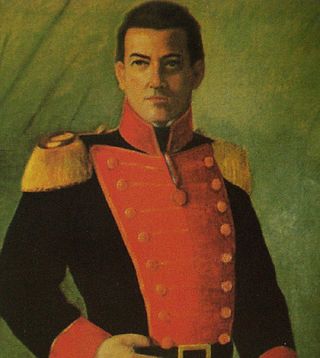
José Gregorio Monagas was the president of Venezuela 1851–1855 and brother of José Tadeo Monagas.

San Felipe is the capital city of Yaracuy, Venezuela. San Felipe is located in the Central-Western Region, Venezuela. The city is an important urban, industrial, commercial and transportation center of Venezuela. San Felipe is the seat of the Roman Catholic Diocese of San Felipe, Venezuela.

Municipalities of Venezuela are subdivisions of the States of Venezuela. There are 335 municipalities dividing the 23 states and the Capital District.

Eloy Palacios Cabello, was a Venezuelan artist, sculptor.

Santiago Mariño Carige Fitzgerald, was a nineteenth-century Venezuelan revolutionary leader and hero in the Venezuelan War of Independence (1811–1823). He became an important leader of eastern Venezuela and for a short while in 1835 seized power over the new state of Venezuela.

Mérida, officially known as Santiago de los Caballeros de Mérida, is the capital of the municipality of Libertador and the state of Mérida, and is one of the main cities of the Venezuelan Andes. It was founded in 1558 by Captain Juan Rodríguez Suárez, forming part of Nueva Granada, but later became part of the Captaincy General of Venezuela and played an active role in the War of Independence.

Fermín Toro y Blanco was a Venezuelan humanist, politician, diplomat and author.

The Eastern Region is one of the 10 administrative regions in which Venezuela was divided for its development plans; it comprises the states of Anzoátegui, Monagas, and Sucre.

The Palacio Municipal de Caracas, or Consejo Municipal de Caracas, is the city hall of Caracas, Venezuela. It is located on the corner of Gradillas a Monjas opposite the Plaza Bolívar, occupying half of the plaza's southern section. The building dates from the seventeenth century but now bears the mark of Alejandro Chataing's Neoclassical additions in 1906. It was the focal point for the Constitutional Convention, and signing of the Declaration of Independence in the nineteenth century. The present building is the result of the work undertaken by the Venezuelan architect Alejandro Chataing in 1906. The west wing of the building, the Capilla de Santa Rosa de Lima, the chapel where Venezuela's independence was declared in 1811, has been fully restored and furnished with authentic period pieces. The ground floor houses the Museo Caracas, which contains works by Venezuela's most celebrated painters and many other historic artifacts. It was declared a National Historic Landmark on 16 February 1979.

The La Guaricha Zoo Also Zoological Park of La Guaricha Is an urban zoo located less than 400 meters from the center of the city of Maturín, Monagas in Venezuela with native species of the region and the rest of Venezuela. The Municipality of Maturín maintains the rectory of the park and the Governorate of Monagas state assumes some administrative responsibility to support the programs that are developed in him.
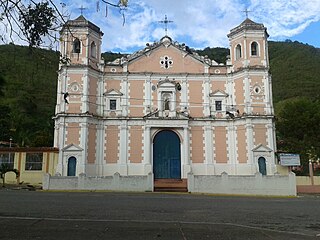
Acosta is one of the 13 municipalities of the state of Monagas, Venezuela. Its capital is San Antonio de Maturín. It has an area of 957 km2 and according to INE estimates its population for 2010 was 19,138 inhabitants. The municipality is made up of two parishes, San Antonio and San Francisco. Its name derives from the politician and leader, José Eusebio Acosta Peña.

The State of Venezuela was the official name of Venezuela adopted by the constitution of 1830, during the government of José Antonio Páez. The name was maintained until 1856 when in the constitution promulgated in that year it changes the official name of the country to Republic of Venezuela. In the Constitution of 1864, the United States of Venezuela was established.

Mateo Manaure was a Venezuelan modern artist. In Venezuela he is considered a master of abstractionism, and is known for his works in the University City of Caracas and for creating the largest glass mural in the world.
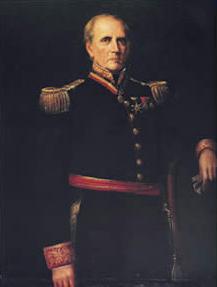
The Venezuelan peasant insurrection of 1846 was a popular and social rebellion that broke out in various agricultural areas of Venezuela in September 1846 and lasted until May 1847.The rebellion was suppressed by the Conservative army.

The Battle of Aragua de Barcelona was fought between Royalists of the Spanish Empire and the Second Republic of Venezuela on 17 August 1814. The battle saw Royalists attack Simón Bolívar's force of 3,000 and win with their 8,000 soldiers. It was a major loss for the Patriots.
